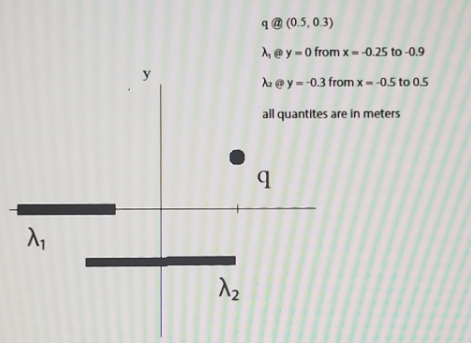1. A point charge of q = 70.0 µC, a line charge segment of A second line charge segment of 2 = 13.0 µC/m are arranged as shown in the Diagram. 17.0 µC/m ând a %3D %3D b) What is the electric field at the origin of the system Due to only the line charge segment, 21? Express this in unit vector notation. c) What is the electric field at the origin of the system Due to only the line charge segment, 2? Express this in unit vector notation.
1. A point charge of q = 70.0 µC, a line charge segment of A second line charge segment of 2 = 13.0 µC/m are arranged as shown in the Diagram. 17.0 µC/m ând a %3D %3D b) What is the electric field at the origin of the system Due to only the line charge segment, 21? Express this in unit vector notation. c) What is the electric field at the origin of the system Due to only the line charge segment, 2? Express this in unit vector notation.
Introductory Circuit Analysis (13th Edition)
13th Edition
ISBN:9780133923605
Author:Robert L. Boylestad
Publisher:Robert L. Boylestad
Chapter1: Introduction
Section: Chapter Questions
Problem 1P: Visit your local library (at school or home) and describe the extent to which it provides literature...
Related questions
Question

Transcribed Image Text:1. A point charge of q = 70.0 µC, a line charge segment of A
second line charge segment of 2 = 13.0 µC/m are arranged as shown in the
Diagram.
17.0 µC/m ând a
%3D
%3D
b) What is the electric field at the origin of the system Due to only the line charge
segment, 21? Express this in unit vector notation.
c) What is the electric field at the origin of the system Due to only the line charge
segment, 2? Express this in unit vector notation.

Expert Solution
Step 1
To calculate the electric field at the origin of the system Due to only the line charge segment, the line charge density given in part A equal to the 17 microC/m.

A point P(0, 0, 0) on the y axis at which to determine the field.
This is a perfectly general point in view of the lack of variation of the field with φ
and z. To find the incremental field at P due to the incremental charge
d Q = ρL dy'
Step 2
Part (C):-
To determine the electric field at the origin of the system Due to only the line charge segment, As the line segment is symmetrical about y axis,
so determine the for the one portion and then multiply with 2,
Trending now
This is a popular solution!
Step by step
Solved in 3 steps with 1 images

Knowledge Booster
Learn more about
Need a deep-dive on the concept behind this application? Look no further. Learn more about this topic, electrical-engineering and related others by exploring similar questions and additional content below.Recommended textbooks for you

Introductory Circuit Analysis (13th Edition)
Electrical Engineering
ISBN:
9780133923605
Author:
Robert L. Boylestad
Publisher:
PEARSON

Delmar's Standard Textbook Of Electricity
Electrical Engineering
ISBN:
9781337900348
Author:
Stephen L. Herman
Publisher:
Cengage Learning

Programmable Logic Controllers
Electrical Engineering
ISBN:
9780073373843
Author:
Frank D. Petruzella
Publisher:
McGraw-Hill Education

Introductory Circuit Analysis (13th Edition)
Electrical Engineering
ISBN:
9780133923605
Author:
Robert L. Boylestad
Publisher:
PEARSON

Delmar's Standard Textbook Of Electricity
Electrical Engineering
ISBN:
9781337900348
Author:
Stephen L. Herman
Publisher:
Cengage Learning

Programmable Logic Controllers
Electrical Engineering
ISBN:
9780073373843
Author:
Frank D. Petruzella
Publisher:
McGraw-Hill Education

Fundamentals of Electric Circuits
Electrical Engineering
ISBN:
9780078028229
Author:
Charles K Alexander, Matthew Sadiku
Publisher:
McGraw-Hill Education

Electric Circuits. (11th Edition)
Electrical Engineering
ISBN:
9780134746968
Author:
James W. Nilsson, Susan Riedel
Publisher:
PEARSON

Engineering Electromagnetics
Electrical Engineering
ISBN:
9780078028151
Author:
Hayt, William H. (william Hart), Jr, BUCK, John A.
Publisher:
Mcgraw-hill Education,